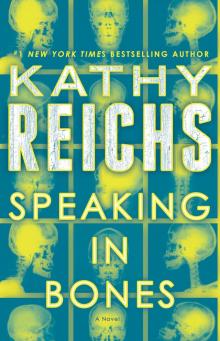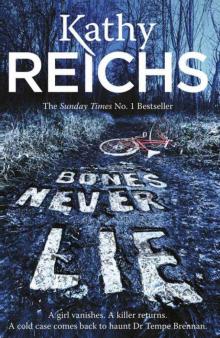- Home
- Kathy Reichs
Speaking in Bones Page 5
Speaking in Bones Read online
Page 5
The clock said 2:47 A.M.
Birdie was up on all fours, back arched, undoubtedly annoyed that I’d interrupted his sleep. I stroked his head, and he settled at my knee.
I closed my eyes.
Inhale.
Exhale.
Calm.
I repeated the mantra again and again. Of course sleep didn’t come. My mind was obsessed with deconstructing the dream. Which typically does not require Freud. Remarkably uncreative, my subconscious simply reworks its recent intake.
The tux and formal table setting represented Ryan’s desire for a wedding, the tuque his Canadian roots and love of Quebec. His disappearance into the black hole needed no explanation.
The woman beside Ryan was Cora Teague. Ditto for her pleading look and sudden exit into oblivion.
Strike was present, playing herself. She wanted me to look for Teague. Larabee, at the opposite end of the table, would probably be opposed, given what little we knew about Strike or the remains labeled ME229-13.
And Daisy? Easy one. Mama was constantly in my thoughts of late.
The Chanel suit and bloody scrubs? Anyone’s guess.
At my last time check, the orange digits glowed 5:54. The alarm buzzed at 7:00.
—
I was at the MCME by eight, spent two hours pounding coffee and composing a final report on the mummified corpse, an elderly gentleman by the name of Burgess Chamblin. When finished, I pulled the file on ME229-13, walked down the hall, and knocked on Larabee’s door.
“Yo.”
I entered and stood in the middle of the room, unsure whether to proceed or to drop the whole thing. My mind shot dual flashbacks. The face in the dream. The audio.
Larabee was writing at his desk, still wearing civvies. “How’s it going?”
“All roses and sunshine.”
“Good.” Still scribbling. Half listening.
“You saw my prelim on the man in the recliner?”
“I did.” Larabee dotted an i. Maybe a j. Slid a handful of photos into a folder and closed it. “Thanks for hopping right on it.”
“I’ve finished the final.”
He glanced up. “That’s great. Thanks.” When I didn’t leave, “Something on your mind?”
“If you have a minute.”
“Grab a seat.”
I dragged a chair forward and sat.
Larabee leaned back and laced long, bony fingers on his chest. Which looked scrawny and concave under his white polo, the result of an overzealous thirty-year commitment to long-distance running.
“Such a crock. No one checks on Grandpa for almost two years, suddenly the kids are on fire to bury the old man.”
“Money involved?”
“Not really.” Larabee’s forehead, permanently lined from hours spent pounding the pavement, furrowed more deeply. “What’s up?”
“I want you to hear me out on this,” I began.
“Don’t I always?”
I made a face, then continued. “A woman came to see me yesterday. Hazel Strike. Strike believes one of our UIDs is a girl named Cora Teague.” I tapped the folder in my lap.
“That’s terrific. Follow up.”
“It’s not so simple.”
“Go on.”
“The remains consist of a handful of bones found in Burke County in 2013.”
“Why did the case come here?”
“I’m not sure.”
“Can you score DNA?”
“That may be problematical on two levels. First, the bone is badly degraded. Acid soil, animal scavenging—”
“Second?”
“The family may be unwilling to provide comparison samples.”
“Why?”
“They don’t believe the kid’s dead.”
Larabee’s brows rose, crimping the furrows.
“They think she took off on her own.”
“So what makes this Strike think our UID is Teague?”
I explained my entry of ME229-13’s identifiers into the NamUs database, then briefed him on websleuthing. On Strike’s visit to Burke County and the disturbing audio. As I spoke, Larabee’s expression morphed from interest to scorn.
“You’re kidding?”
I wagged my head no.
“Fine. Play me this Blair Witch moment.”
“Strike refused to leave the recorder with me.”
“Jesus, Tempe.”
“What was I supposed to do, rip it from her hand?”
Larabee’s phone rang. He ignored it.
“What do you propose?” he asked.
“Perhaps I should go up there. Maybe take Joe, run a cadaver dog through the woods below the overlook.” Joe Hawkins is a death investigator who’s been with the MCME since the Eisenhower years. If any bone remained on that mountain, Joe Hawkins would find it. Or the canine would.
Larabee gave the idea some thought. Then, “You say the remains were already badly damaged when they arrived in 2013. What are the odds more could have survived?”
“It’s possible.”
“Likely?”
I shrugged.
“Who worked the recovery?”
“A Burke County deputy sheriff.”
“Have you talked to him?”
“Her. Opal Ferris. She was unavailable. I left a message.”
“Did the NOK file an MP report?” Larabee used the shorthand for next of kin.
I shook my head.
“Who put Teague up on this CLUES site?”
“There’s no way to know. All posters are allowed to remain anonymous.”
Larabee’s face executed something between a grimace and a scowl. Held the expression several seconds. Then he said what I’d expected.
“I can’t commit funds or personnel to something this thin. Phone back up to Burke County. Talk to Ferris. See where that goes.”
I nodded. Got to my feet and returned to my office.
This time Opal Ferris took my call.
I introduced myself. Ferris remembered me. And the bones. And her trek around the mountain with Mort. She asked if new info had surfaced.
For what seemed the hundredth time I went through the recent time line, focusing on developments unknown to Ferris. Websleuthing. Strike’s NamUs epiphany and visit to Burke County. Cora Teague. The audio.
Ferris listened. I think. There seemed to be a lot going on in the background.
“This key chain thingy was just lying in the dirt?” Ferris’s voice was raspy, maybe from smoking, maybe from vocal cords working on a node.
“So Strike claims.”
“And the family thinks the kid’s run off with some local fella?”
“I’m unsure of his place of residence.”
“But the bottom line is she’s not been reported missing.”
“Except on CLUES.”
“Which any pig nut can access.”
I said nothing.
“Teague have a cellphone?”
“No.”
“Any Internet presence?”
“Not according to Strike.”
“Uh-huh. I’m sorry, Doc. But it don’t sound like you’ve got squat. A few bones in Burke, someone who may or may not be missing in Avery. That someone being eighteen and free to stay gone if she chooses.”
It was hard to argue with that.
“Can you make a couple of calls?” I asked. “See if the mother or one of the sisters is willing to provide a DNA sample?”
I waited. Quite a while. When I was sure Ferris was about to blow me off, she said, “I’ll get back to you.”
—
Ferris didn’t. But an Avery County deputy sheriff named Zeb Ramsey did. At four that afternoon, as I was pulling into my drive.
The mother and both sisters had refused to allow themselves to be swabbed. Though none of them had heard from Cora since 2011, all believed she was alive and doing just fine.
Deputy Ramsey sounded about as fired up about the situation as Ferris had been. Disconnected before I could pose a si
ngle question about the Teague family.
First Ryan, now Larabee, Ferris, and Ramsey. The enthusiasm level was sending streaks of tension straight up my back.
I tossed my mobile onto the dash and gave it the finger. In answer, it rang. I snatched it up, thinking Ramsey was calling back.
“Brennan.”
“Sounds like you’re having a real bad day.”
“I’m off duty, Ms. Strike.”
“Mrs.”
I sighed, considered whether to beg off or simply disconnect.
“I won’t chew your ear, just wanted to invite you so’s everything’s on the up and up. I aim to take another pass at that overlook tomorrow.”
“You’re returning to Burke County?”
“Yep.”
“You shouldn’t do that.”
“I don’t, who will?”
“I appreciate what you’ve done. But it’s time to hand the investigation off to professionals.”
“Yeah? They kicked free any leads?”
So far no one I’d contacted gave a rat’s ass. I kept that to myself.
“Well, I have.” Strike allowed a lengthy silence, perhaps to show who was in charge. “Remember the youngest Teague kid? The one I didn’t know what become of?”
“Eli.”
“Little Eli died shortly after his twelfth birthday.”
“Died how?”
“I don’t know. I can’t get access to medical files.”
“Children die. It could mean nothing.”
“Or it could mean something.”
“How did you learn about his death?”
“I have my ways.”
“When are you going?”
“Plan to be there by eight A.M.”
I thought of the reaming I’d get from Larabee. And of the damage Strike might do should additional evidence or remains still lie on that mountain.
Digging a small spiral from my purse. “Give me directions.”
Strike did. I jotted them.
“Do nothing until I arrive,” I said. “And bring the recording.”
“Never hurts to say please.”
The line went dead.
I sat a moment, iPhone warm in my hand. Was Strike onto something? Had one of Teague’s parents harmed Eli? Had one of them killed Cora then tossed her body from the overlook?
Or was I being drawn into a lunacy that existed only in the mind of Hazel Strike?
I didn’t want to go to that mountain.
But something told me that not going would be a big, big mistake.
I made a decision.
Thumbed a button on my mobile and waited.
In the Blue Ridge Mountains of North Carolina, on the border between Burke and Caldwell counties, a hunk of igneous and metamorphic rock buckles up from the lush greenery of the Pisgah National Forest. As summits go, the buckle isn’t all that impressive, 2,600 feet high and a mile and a half long. But the wee peak has inspired Cherokee myths, folk legends, scientific studies, websites, YouTube footage, a modest tourist industry, and at least one popular song. It appears on every list of haunted sites in North America. All because of oddball lights.
For centuries, mysterious illuminations have been observed above and on Brown Mountain. According to eyewitness accounts, the small fiery orbs appear, rise to a fair height, then vanish below the ridgeline. Hundreds have reported seeing the lights, including locals, visitors, and those who have traveled to North Carolina for just that purpose.
Theories abound. The reflection of fires at moonshine stills. Swamp gas. Lantern-bearing Cherokee widows searching for the souls of husbands lost in battle.
The “ghost lights” have merited two investigations by the United States Geological Survey, the first in 1913, another in 1922. Official reports attributed the phenomenon to locomotives, cars, and occasional brush fires. Many folks don’t buy it. Especially the Cherokee.
As I followed my scribbled directions, which were barely legible, I had no idea I was heading to an overlook specifically constructed for viewing Brown Mountain. Nor was I well informed on the marvelous lights. I learned all of that after arriving, reading a sign, and doing a quick Google query while waiting for the rest of the team.
In the predawn hours, traffic was negligible, so I took the scenic route. I-40 to Morganton, then NC 181 north toward Jonas Ridge and Pineola. As I got on the two-lane, there was enough light to enjoy the view. The foothills and mountainsides were still glazed with frost, giving the landscape an ethereal, sugarcoated appearance. As the sun sent out its first tentative feelers, I watched the gaps between elevations ooze from black to gray to pinkish yellow.
Knowing the turnoff was easy to miss, Strike had provided GPS coordinates. The woman was thorough, I had to give her that. And right. I never saw it coming.
Ninety minutes after leaving Charlotte, my iPhone beeped to let me know that I’d arrived at my destination. I braked, cut from the blacktop, and pulled to a stop in a paved parking area. Mine was the only vehicle present.
After killing the engine, I lowered a window. The air smelled strongly of pine and chilled vegetation, faintly of petroleum caught in gravel scattering the shoulder of the road.
Absolute silence reigned in the woods around me. Not a single bird twittered or cawed a welcome or warning. No small creature rustled the undergrowth hurrying home from a night of hunting or setting out for a breakfast stalk.
I grabbed a jacket from the backseat and slipped on gloves. Then, moving slowly to avoid making noise, I got out of my car. Pointless, since I was alone.
The overlook was bordered by a low steel barrier fitted with signs. I crossed to one, boot heels clicking in the stillness. According to the Burke County Tourism Development Authority, Brown Mountain could be seen directly ahead, Jonas Ridge opposite, behind my back.
I squinted into the far distance. Picked out a smoke-colored smudge riding the horizon. Not a light in sight. But I hadn’t come in pursuit of a selfie with ghostly vapors. Mind kicking into scientist mode, I assessed my surroundings.
If today was typical, the overlook was often deserted. Quick exit from the highway, short walk to the guardrail, quick reentrance to the north- or southbound lane, gone. The overlook was perfect for a body dump.
After nineteen months there was little chance we’d find evidence left by that vehicle. A tire track, a paint chip, a fiber from a carpet or floor mat. For the billionth time, I wondered what on earth I hoped to accomplish.
The sound of an engine caused me to turn.
A black Range Rover was pulling to a stop beside my Mazda. An Avery County Sheriff’s Department logo told me Deputy Ramsey had arrived. A dog’s silhouette was visible in the backseat.
As Ramsey unbuckled his safety belt, I walked toward him. The dog rubbernecked my way, watching through the glass like a New Yorker in a taxi.
“Doctor Brennan?” My name rode a small white cloud coning from Ramsey’s lips.
“Tempe. You must be Deputy Ramsey.”
Yanking off a glove to extend a hand. “Zeb.”
We shook. Ramsey’s grip was strong, but not a testosterone killer. I liked that.
“Sorry this had to fall on you,” I said.
“If you’ve got a dead kid from Avery, that’s my turf.”
“Deputy Ferris was reluctant to reengage.” That was an understatement.
“So I gathered.”
“I hope I haven’t dragged you out here on an April Fool’s errand.”
“If you have, explain it to Gunner.” Ramsey tipped his head in the direction of his canine companion. About whom I had doubts. Which I’d expressed on the phone the previous day.
“You’re sure he’s cadaver qualified?” I asked.
“Cadaver, drug, fugitive. Taught him myself.”
“So you said.” Trying to hide my skepticism. I’ve worked with a lot of cadaver dogs, canines specially trained to locate corpses. It’s a distinct skill, different from sniffing out drugs or tracking live individuals, and requi
res a distinct training protocol. I’d never encountered a dog that was good at all three tasks. Or one coached by an amateur.
An awkward moment passed.
“Did Deputy Ferris tell you about Hazel Strike?” I asked, wondering how the description had been phrased.
“She did.”
“Strike’s a bit of an odd duck.”
“She running late?” A hint. Ramsey wanted to move this along.
“She said eight. Can we give her a few more minutes?”
Tight nod.
Zeb Ramsey’s features were pleasant enough—brown eyes, straight nose, brows that didn’t meet in the middle. Until he smiled. Then the whole shifted into wonderful alignment.
Whoa-ho.
“May as well make introductions.” Ramsey crossed to the cruiser and opened a rear door.
Gunner’s parentage involved very large animals. Black, brown, and white coloring and a sprightly upcurl to his tail suggested a shepherd-chow mix.
My sort-of ex, Pete, has a chow. Gunner didn’t alight in the manner Boyd would have chosen, body flying, paws scrabbling as they hit the ground. He hopped out with controlled elegance and, eyes never leaving Ramsey, padded up to me and sat.
I looked to Ramsey. He nodded permission. I extended a hand, palm down, to allow Gunner to check out my scent. The dog sniffed, then licked my fingers with a long purple tongue. Definitely chow swirling in the gene pool.
I was stroking Gunner’s head when a battered red Corolla turned from the highway. Slamming to a stop beside my Mazda, Hazel Strike killed the engine and flew from the car, showing none of the restraint the dog had exhibited.
As Strike stormed toward us, Ramsey spread his feet and curled one end of the leash around a palm. Gunner tensed.
“Didn’t know we’d have company,” a scowling Strike said to me, back pointedly turned to Ramsey.
“Mrs. Strike, this is Deputy Ramsey.”
“Don’t see no reason for an army of cops.” A tiny vein snaked the center of Strike’s forehead, blue and sinuous and pumping like mad.
Unsure of the source of Strike’s anger and, frankly, not caring, I ignored the comment. “The dog’s name is Gunner.”
More of the hard stare, then Strike started to speak. I cut her off.
“Deputy Ramsey and I will walk Gunner in a systematic pattern, using standard search procedure. If remains or evidence are found, all materials will be photographed in place, then sealed into containers following chain of custody protocol. You may come along if you walk directly behind us in terrain that’s already been searched. If that’s unacceptable, I will have to ask you to wait up here in your car.” Firm, and not all that gentle.

 Two Nights
Two Nights The Bone Collection: Four Novellas
The Bone Collection: Four Novellas Fatal Voyage
Fatal Voyage 206 Bones
206 Bones Bones to Ashes
Bones to Ashes Terminal
Terminal Monday Mourning
Monday Mourning Flash and Bones
Flash and Bones Cross Bones
Cross Bones Devil Bones
Devil Bones Break No Bones
Break No Bones Swamp Bones
Swamp Bones Déjà Dead
Déjà Dead Shock
Shock Spider Bones
Spider Bones Death Du Jour
Death Du Jour Grave Secrets
Grave Secrets Trace Evidence: A Virals Short Story Collection
Trace Evidence: A Virals Short Story Collection Bones on Ice
Bones on Ice The Bone Code
The Bone Code Bones in Her Pocket
Bones in Her Pocket Seizure:
Seizure: Speaking in Bones
Speaking in Bones Deadly Decisions
Deadly Decisions Spike
Spike Bones Never Lie
Bones Never Lie Bones of the Lost
Bones of the Lost Virals 03.5 - Swipe
Virals 03.5 - Swipe Exposure
Exposure A Conspiracy of Bones
A Conspiracy of Bones Shift (tory brennan)
Shift (tory brennan) Bones of the Lost: A Temperance Brennan Novel tb-16
Bones of the Lost: A Temperance Brennan Novel tb-16 Virals tb-1
Virals tb-1 Bones Are Forever tb-15
Bones Are Forever tb-15 Code tb-3
Code tb-3 Seizure tb-2
Seizure tb-2 Deadly Descisions
Deadly Descisions Spider Bones: A Novel
Spider Bones: A Novel